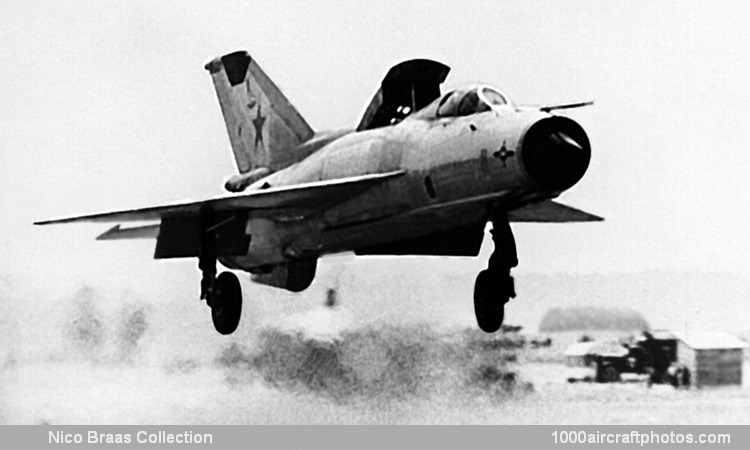The 23-31 was essentially a MiG-21PFM with the fuselage from Frame 12 back to the junction with the rear fuselage at Frame 28A completely redesigned to house two RD-36-35 lift jets, equally disposed ahead of and behind the center of gravity. This engine was a simple turbojet designed to give lift for short periods at take off or landing. sea level thrust was 5,381 lb (2,350 kg) each. They were not pivoted but fixed at an inclination of 80°, fed from the ordinary fuel tanks and started by turbine impingement jets fed by air bled from the main engine.
The lift-engine bay was considerably bulkier than the original fuselage section. Air for the lift engines was fed through a large louvred door forming the top of the center fuselage, which in jet-lift flight was hinged at the rear and pushed up by a ram. Along the underside of the bay was a vectoring box, a rectangular frame containing transverse curved vanes, seven under each jet. Made of heat-resisting steel, these were pivoted and interlinked so that they could be vectored by the pilot through an angular range of some 50°, to give forward thrust or braking.
No attempt was made to achieve a streamlined high-speed aircraft. Extra inboard wing sections were added, set at a positive angle of attack, which increased track from the standard 8 ft 10 in (2.69 m) to 11 ft 1.875 in (3.40 m). Wheel base was increased to 16 ft 10.75 in (5.15 m). The lift-engine bay made it impossible for the main landing gear to retract, and the nose unit was also non-retractable, all wheel and leg bays being skinned over.
Bleed air pipes from the main engine supplied reaction-control jets for use at low airspeeds. A nozzle pointed down under each wing tip, and a third under the nose, served by external pipes along each side of the fuselage. Only one airbrake was fitted, of a unique design ahead of the lift-jet bay. Under the nose were a drift sensor and telemetry antenna. Black/white kinetheodolite targets were painted on the left side of the nose and rear fuselage.
The 23-31 was first flown by P.M. Ostapenko on June 16, 1966. He found that 'For take off you need maximum dry power on the main engine, but for landing you need afterburner!' He shared factory testing with B.A. Orlov. The 23-31 was basically unstable at low airspeeds, and control was inadequate. It took part in a public display on July 9, 1967, and was then retired. It was donated to the Moscow Aviation Institute but has since disappeared.
In official Soviet circles the designations Ye-7PD (PD for podyomnyedvigatyeli or lift engines) and Izdeliye 92 (article or product 92) were used as well, while NATO assigned it the code name "Fishbed-G", and the western press dubbed it MiG-21PD."
